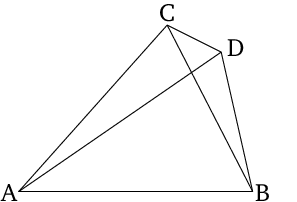On the same straight line, two other straight lines equal, respectively, to two (given) straight lines (which meet) cannot be constructed (meeting) at a different point on the same side (of the straight line), but having the same ends as the given straight lines.

Suppose two distinct triangles \(\triangle{ABC}\) and \(\triangle{ABD}\) share a common base \(\overline{AB}\) and lie on the same side of it. Also suppose that at one endpoint of the base, e.g. \(A\), the two sides connecting to \(A\) are equal in length: \(\overline{AC}=\overline{AD}\). Then the lengths of the sides connected to the other endpoint of the base (point $B$), are unequal in length: \(\overline{BC}\neq\overline{BD}\).
Proofs: 1